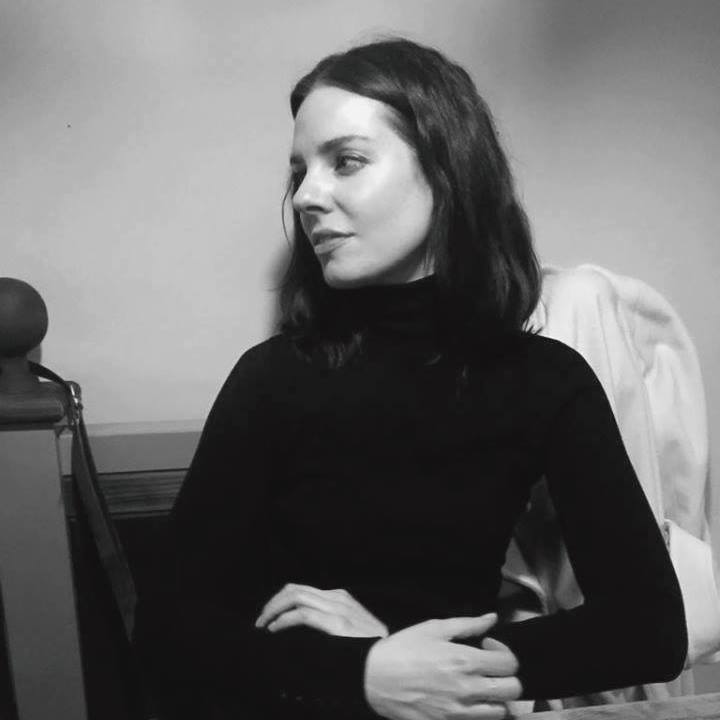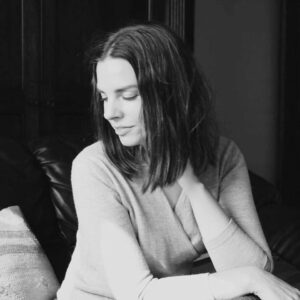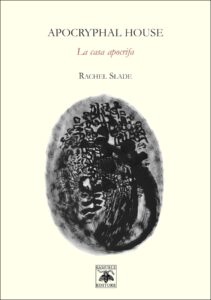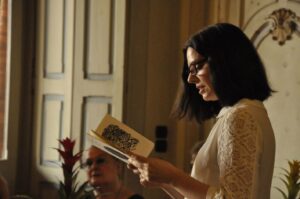
In occasione del 24° Premio di Poesia Ossi di Seppia Laboratori Poesia chiede ai vincitori delle passate edizioni di recensire i vincitori della presente. Le uscite saranno a cadenza domenicale. Partiamo col Primo Premio Rachel Slade recensita dalla vincitrice del 23° Premio Ossi di Seppia Eleonora Rimolo.
On the occasion of the 24th annual poetry award ‘Ossi di Seppia‘, Laboratori Poesia asks the winners of past editions to review this year’s winners. The posts will be published each Sunday. We open the series with the First Prize award winner, Rachel Slade, reviewed by the winner of the 23rd Ossi di Seppia Award, Eleonora Rimolo.
L’IMMENSA STRUTTURA DELLA FELICITÀ
Nota di lettura a Apocryphal House – La casa apocrifa
di Rachel Slade (Samuele Editore, 2016)
di Eleonora Rimolo
Immagini e suoni nella poesia di Rachel Slade si intrecciano con eleganza fino a creare un dipinto nel dipinto (la calendula delle calendule / nella tua campagna delle campagne): la sua abilità nel dare forma alle cose, ai colori, alle parole e a tutto quello che nella realtà appare come informe e muto ci permette di leggere versi la cui potenza simbolica è evidente (io vivo tra le densità […]/ io sono l’immenso candore dell’occhio / e il puntino di dolore). Rachel Slade chiama le cose col proprio nome, le dipinge con la propria struttura e cerca disperatamente in tal modo questa corrispondenza non sempre manifesta tra soggetto del canto e la sua definizione. Qual è il confine tra la verità delle cose e la loro rappresentazione (il tuo libro ha tanti fiori. alcuni veri, alcuni disegnati)? Il poeta se lo chiede quasi ossessivamente in ogni testo della raccolta, lasciando intendere che un intervallo incolmabile divide le due dimensioni – il reale e l’ideale: raccogliere la confusione a mani piene pare dunque l’unica strada percorribile per potersi muovere all’interno di una vischiosa rete di voci, rami, presenze umane e animali dal tratto inquietante in cui siamo prigionieri. Lo spazio vuoto che separa, la distanza inspiegabile, sono elementi che ritornano nei versi di Rachel Slade e non risparmiano nemmeno la forza e la nobiltà del sentimento d’amore (Ci sono baratri da attraversare / tra di noi, anche se ti amo): tuttavia, se il desiderio ha un limite (Va oltre quello che possiamo / qui nel palmo semichiuso della vita / e del sonno e delle domande), cosa interporre allora tra la possibilità e il desiderio? Come dare colore, e quindi contorno, al nulla che separa, lacerando? È possibile riavvicinare i lembi di questa ferita aperta che è la vita, anche solo per un momento? C’è una piccola miniatura nel profondo dove il sole ti cade sul collo: probabilmente in quell’impercettibile, piccolissimo granello di esistenza si cela la materia da plasmare per poter creare un ponte di unione tra le cose, tra le persone lontane, nell’ infernale disordine delle pieghe. Ma quasi nulla è dato sapere con certezza. Esiste in definitiva un confine che pittura, poesia e memoria non potranno mai oltrepassare: la morte. In quel caso si è solo un’isola di neve e cose addormentate nella neve, e il nero intenso delle figure contenute nella plaquette sfuma sempre di più, fino a diventare un grigio tenue e a scomparire, fondendosi, nel bianco latte della pagina. Si strugge a questo punto l’autrice nella cecità più atroce; i versi si contraggono, la geometria dei disegni si infittisce: in un ultimo spasimo frenetico del wille schopenhaueriano Slade ammette di essere forma solida in campo metafisico deponendo le armi della conoscenza non per dichiarare la resa, ma per continuare una lotta parallela nel nome della poesia e dell’arte, unici strumenti capaci di contrastare la consunzione del tempo umano e di rendere ogni atto poetico e artistico una stella di pietra, dura ma luminosa, solida ma impalpabile, e pertanto miracolosa.
THE IMMENSE STRUCTURE OF HAPPINESS
Reader’s Note: The Apocryphal House/La casa apocrifa
by Rachel Slade (Samuele Editore, 2016)
by Eleonora Rimolo
Images and sounds in Rachel Slade’s poetry intertwine with refinement to create a painting within a painting (marigold of marigolds / in your field of fields): her ability to give form to things, colors, words and everything that in reality appears formless and silent, allows us to read verses whose symbolic power is evident (I am living among the densities […] / I am the immense whiteness of the eye / and the pinpoint of sorrow). Rachel Slade calls things by their proper name, paints them according to their own structure and in this way desperately searches for the correspondence that is not always clear between the subject and its definition. What is the boundary between the truth of things and their representation (Your book has many flowers. Some real, some drawn.)? The poet asks this almost obsessively in each text of the collection, suggesting that an unbridgeable gap divides two dimensions – the real and the ideal: to collect your confusion in handfuls seems the only feasible way to be able to move within a viscous network of voices, branches, human and animal presences in the disturbing tract in which we are prisoners. The empty space that separates, the inexplicable distance, are elements that return in the verses of Rachel Slade that do not withhold even the strength and nobility of feelings of love (There are chasms for it to cross / between us, even though I love you): however, if desire has a limit (It goes further than we can / here in the nearly closed palm of living / and sleeping and asking), what interposes then between possibility and desire? How to give color, and therefore contour, to the nothing that separates, that tears? Is it possible to bring the edges of the open wound that is life back together, if only for a moment? There is a piccola miniatura nel profondo where there is the sun falling on your neck: probably in that imperceptible, tiny grain of existence hides the material to be molded in order to create a bridge of union between things, between far-away people, in the paper hell of creases. But almost nothing is known with certainty. Ultimately there is a boundary that painting, poetry and memory can never go beyond: death. In this case, one is only an island of snow and things fallen asleep in the snow and the intense black of the drawn figures contained in the plaquette fades more and more, becoming pale gray and disappearing, melting, into the milky white of the page. At this point, the author is consumed in a ferocious blindness: the verses contract, the geometry of the drawings thickens: in a last frantic spasm of Schopenhauerian will, Slade admits to being a solid form in the metaphysical field depositing the weapons of knowledge, not to declare surrender, but to continue a parallel struggle in the name of poetry and art, the only instruments capable of countering the consumption of human time and rendering every poetic and artistic act a stone-star, hard but luminous, solid but impalpable, and therefore miraculous.

In your book of flowers we find three forms –
I. A black rag in white pearl background:
a woman’s body suspended in frame, still standing.
II. A golden silhouette, a jar
on the edge of the page.
It traces the veins of the leaf that spreads itself across the tree.
III. A careful measurement between trees in a forest,
thin black filaments between them. The distances expanding.
They measure the hard fall between them.
Hands steady inside pockets.
You will read to me later.
Will you read to me again.
Read to me each night in at least two languages
this way something will remain by morning.
Your book has many flowers. Some real, some drawn.
Will you show me the dark body of prayer?
Il Libro dei Fiori
Nel tuo libro dei fiori ci sono tre figure – / I. Uno straccio nero su uno sfondo bianco perla: / un corpo di donna sospeso nella cornice, ancora in piedi. // II. Una silhouette dorata, un vaso / sull’orlo della pagina. / Traccia le vene della foglia sparse per tutto l’albero. // III. Una misura attenta tra ogni albero della foresta, / sottili neri filamenti tra di loro. Espandendo la distanza. / Misurano la dura caduta tra di loro. / Le mani quiete nelle tasche. // Leggerai per me più tardi. / Leggerai per me di nuovo. / Leggi per me ogni notte in almeno due lingue / così qualcosa resterà alla mattina. // Il tuo libro ha tanti fiori. Alcuni veri, alcuni disegnati. / Me lo mostrerai il corpo buio della preghiera?

First, was the gold foil edge under a smooth hand
a dry bay leaf waved over our infant shadows
a song without words
the skull on the garden wall, eggshells in the pail.
Angles and planes tell the story:
this is not trying to be a painting
stop the paper hell of creases.
My shoe came off in his hand.
Then we both forgot at once, at the same time.
While the mechanism turned and worked,
we wanted the perfection of a horse
between our hands.
Sex is a simple orange
turning white under the weight of ashes.
I slept with my head down.
We grow thin and transparent under our own gaze.
Observation renders us invisible and we burn like hunger.
On this page your blurred thumbprint
your smear that burns through.
Meccanismo
All’inizio, / era un bordo di foglia d’oro sotto una mano liscia / una foglia d’alloro disseccata sventolando / sulle nostre ombre bambine, una canzone sorda / il teschio sul muro del giardino, i gusci d’uovo nel secchio. / Angoli e piani narrano la storia: / questo non tenta nemmeno di essere un quadro / blocca quest’infernale disordine delle pieghe. // La mia scarpa gli è rimasta tra la mani. / Ce ne siamo dimenticati entrambi, nello stesso momento. / Mentre il meccanismo girava e funzionava / volevamo la perfezione di un cavallo / tra le nostre mani. // Il sesso era una clementina / imbiancata dal peso della cenere. / Dormivo con la testa all’ingiù. // Diventiamo sottili e trasparenti sotto il nostro sguardo. / L’osservare ci rende invisibili e bruciamo come fame. / Su questa pagina la tua orma sfocata / la tua impronta che incendia.

